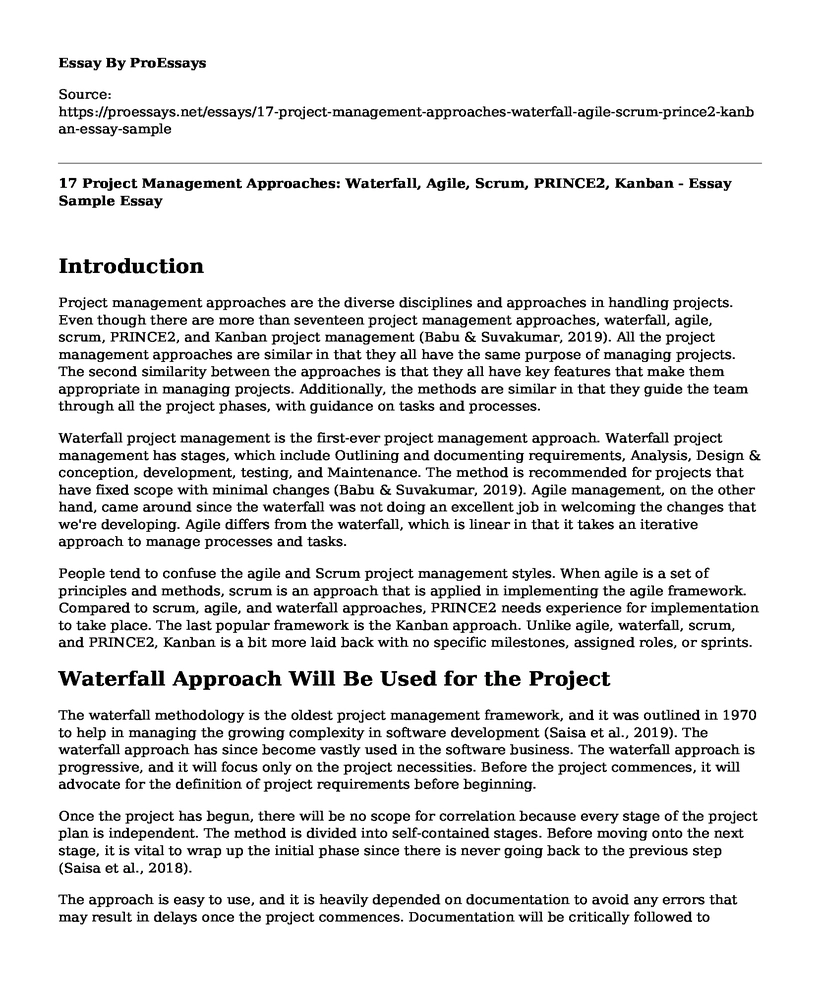Introduction
Project management approaches are the diverse disciplines and approaches in handling projects. Even though there are more than seventeen project management approaches, waterfall, agile, scrum, PRINCE2, and Kanban project management (Babu & Suvakumar, 2019). All the project management approaches are similar in that they all have the same purpose of managing projects. The second similarity between the approaches is that they all have key features that make them appropriate in managing projects. Additionally, the methods are similar in that they guide the team through all the project phases, with guidance on tasks and processes.
Waterfall project management is the first-ever project management approach. Waterfall project management has stages, which include Outlining and documenting requirements, Analysis, Design & conception, development, testing, and Maintenance. The method is recommended for projects that have fixed scope with minimal changes (Babu & Suvakumar, 2019). Agile management, on the other hand, came around since the waterfall was not doing an excellent job in welcoming the changes that we're developing. Agile differs from the waterfall, which is linear in that it takes an iterative approach to manage processes and tasks.
People tend to confuse the agile and Scrum project management styles. When agile is a set of principles and methods, scrum is an approach that is applied in implementing the agile framework. Compared to scrum, agile, and waterfall approaches, PRINCE2 needs experience for implementation to take place. The last popular framework is the Kanban approach. Unlike agile, waterfall, scrum, and PRINCE2, Kanban is a bit more laid back with no specific milestones, assigned roles, or sprints.
Waterfall Approach Will Be Used for the Project
The waterfall methodology is the oldest project management framework, and it was outlined in 1970 to help in managing the growing complexity in software development (Saisa et al., 2019). The waterfall approach has since become vastly used in the software business. The waterfall approach is progressive, and it will focus only on the project necessities. Before the project commences, it will advocate for the definition of project requirements before beginning.
Once the project has begun, there will be no scope for correlation because every stage of the project plan is independent. The method is divided into self-contained stages. Before moving onto the next stage, it is vital to wrap up the initial phase since there is never going back to the previous step (Saisa et al., 2018).
The approach is easy to use, and it is heavily depended on documentation to avoid any errors that may result in delays once the project commences. Documentation will be critically followed to prevent additional costs that may lead to the project budget being exceeded. The methodology will work best because the project is simple and has fixed and clear recommendations on the schedule, work plan, and risk management strategy.
Further, the waterfall approach is the best because progress can be easily be measured as the entire scope of the project is known in advance. Through the development efforts, various project team members can be involved and can work on other tasks depending on the project's active phases. For instance, the finance officer can work on other jobs in the facility while other team members work on other projects. Considering that there are so many requirements in the project, the waterfall approach project sponsors are not strictly required after the requirements phase except for the approvals, reviews, and status meetings.
References
Babu, T. D., & Sivakumar, V. (2019). EXPLORING CONFLUENCE OF AGILE AND TRADITIONAL PROJECT MANAGEMENT METHODOLOGIES IN IT PROJECTS. Indian Journal of Applied Research, 9(1).
Saisa, M., Tiura, K., & Roslof, J. (2018). Waterfall vs. agile project management methods in university-industry collaboration projects.
Cite this page
17 Project Management Approaches: Waterfall, Agile, Scrum, PRINCE2, Kanban - Essay Sample. (2023, Feb 27). Retrieved from https://proessays.net/essays/17-project-management-approaches-waterfall-agile-scrum-prince2-kanban-essay-sample
If you are the original author of this essay and no longer wish to have it published on the ProEssays website, please click below to request its removal:
- Acquiring and Retaining New Customers and Starting a Business Essay
- Paper Example on Leadership and Management
- Project Procurement Paper Example
- Types of Arguments: Deductive, Inductive, Plausible, Argument Forms - Essay Sample
- Preliminary Report: Project Mgr Roles, Objectives & Responsibilities - Essay Sample
- Essay Example on Leaders: Inspiring Direction and Pursuing the Right Thing
- Vancity: Achieving Competitive Advantage with Healthy Work Environment - Essay Sample







